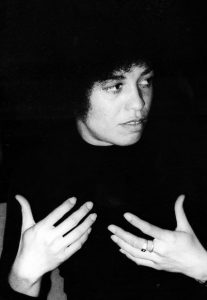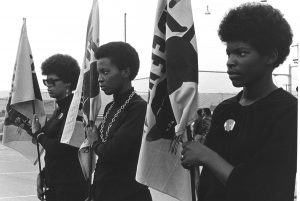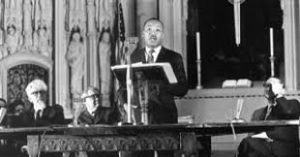Angela-Davis-Are_Prisons_Obsolete


A History of Black America
“Free Angela and All Political Prisoners’ by Shola Lynch”

by Nicolas Rapold
“Shola Lynch’s documentary about Angela Davis, the activist and beacon of counterculture radicalism, is a snappily edited, archivally wallpapered recollection of fearless behavior in the face of an antsy establishment. But it’s equally significant as a pointed act of retelling.”



“Though the Attica prison uprising was nearly a half-century ago, the catastrophic event — the nation’s deadliest prison riot — has again become a touchstone issue in conversations about prison conditions and reforms.
In western New York, Attica has long remained a historical scar that is memorialized annually. But two books released in the past 13 months brought renewed national attention to the September 1971 riot. And, those two books are key to events at area universities that will remember the uprising and its significance.”
“Black Power and the Gendered Imaginary” by Jakobi Williams and Andrea M. Sterling

“Ashley D. Farmer’s Remaking Black Power: How Black Women Transformed an Era is an essential new text in the recent historiography of Black Power. Remaking Black Power argues that Black women’s constructions, re/imaginings, and re/definitions of womanhood are crucial sites for the expression and building of Black Power. Farmer situates Black women subjects as integral components of Black Power, as she centers Black women as theoreticians, symbols, political actors via their ideas–their activism in concert with political imaginings, and their diverse visions of Black womanhood within the context of political and cultural organizing. She categorizes the contributions of Black women in the twentieth century as “The Militant Black Domestic,” “The Revolutionary Black Woman,” “The African Woman,” “The Pan-African Woman,” and the “Third World Woman.” The struggle and work produced by these Black women were inherently intersectional—they pushed against forced definitions of Blackness imposed by western/mainstream society and challenged sexist and limiting ideas of womanhood and gender produced by the larger patriarchal society.
Black women utilized their visual art, creative writing, speeches, and community work also to challenge the predominately men-centered popular beliefs of Black Power. The work created by these women pushed them into the center as opposed to them only operating on the periphery of Black Power, due in part to their re-imagining of leadership and action. Farmer argues that the redefinition and re-imaginings of self and identity conducted by these Black women are reflective of more extensive ideologies that Black resistance groups were following: the desire to redefine themselves outside the constructions and definitions imposed upon them by the white hegemonic power structure. In the first chapter, Farmer focuses on how the “Militant Negro Domestic” asserted her power and activism in the Black nationalist movement prior to Stokely Carmichael’s creation of the term “Black Power” in 1966. The next chapter centers Panther women in the heart of the most popular Black Power group, the Black Panther Party. Panther women directly proclaimed their agency to ensure that the Black Panther Party projected a less-patriarchal view of Black nationalism and international solidarity. The third chapter documents the evolution of the “African Woman” that challenged Karenga’s men-led Kawaida to incorporate a more feminist, anti-capitalist vision of Black activism that rejected gendered hierarchies. Chapter four examines the “Pan-African Woman” that forged solidarities with African nations resisting colonialism and those that acquired independence and sovereignty. Black women’s involvement in the planning of the 6th International Pan-African Conference in Tanzania highlighted the gender-inclusive modes of activism as a significant policy of the Black liberation struggle. The fifth chapter expands upon the previous chapter by closely examining the “Third World Black Woman” that aligned with all women of color and advocated for the erasure of gendered hierarchies in anti-colonial and anti-white hegemonic cultural-resistance struggles. Farmer is careful to distinguish between each model of Black womanhood, but also she lists how they overlapped, interacted, and left some aspects of patriarchal activism untouched.”
On Tuesday, as we watched Black Power Mixtape, Questlove and Harry Belafonte mentioned King’s radicalism and critique of militarism and inequality. Here’s MLK, Jr._Beyond Vietnam_A Time to Break Silence his speech, and below the recording.

“Beyond Vietnam: A Time to Break Silence” MLK, Jr. 1967
“Mr. Chairman, ladies and gentlemen, I need not pause to say how very delighted I am to be here tonight, and how very delighted I am to see you expressing your concern about the issues that will be discussed tonight by turning out in such large numbers. I also want to say that I consider it a great honor to share this program with Dr. Bennett, Dr. Commager, and Rabbi Heschel, some of the most distinguished leaders and personalities of our nation. And of course it’s always good to come back to Riverside Church. Over the last eight years, I have had the privilege of preaching here almost every year in that period, and it’s always a rich and rewarding experience to come to this great church and this great pulpit.
I come to this great magnificent house of worship tonight because my conscience leaves me no other choice. I join you in this meeting because I am in deepest agreement with the aims and work of the organization that brought us together, Clergy and Laymen Concerned About Vietnam. The recent statements of your executive committee are the sentiments of my own heart, and I found myself in full accord when I read its opening lines: “A time comes when silence is betrayal.” That time has come for us in relation to Vietnam.”